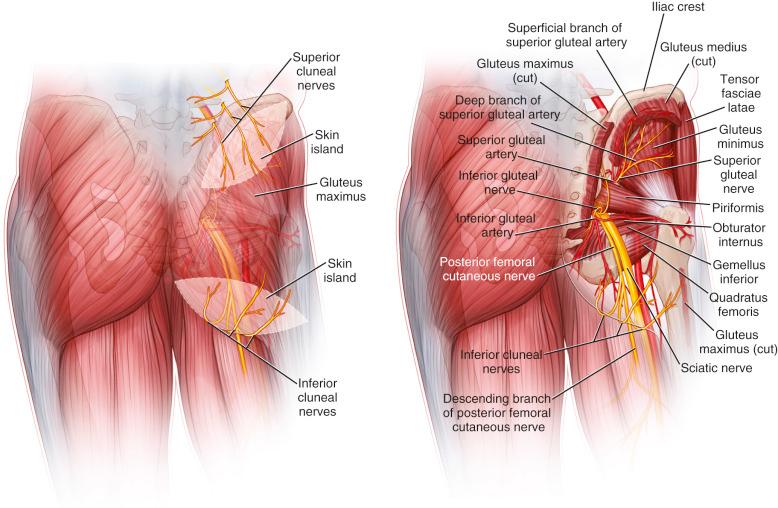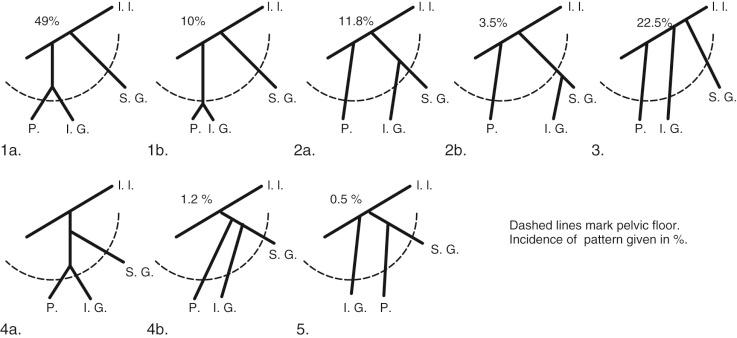Physical Address
304 North Cardinal St.
Dorchester Center, MA 02124
The superior gluteal myocutaneous free flap was first described by Fujino in 1975 for breast reconstruction. In 1978, Le Quang performed the first breast reconstruction with an inferior gluteal myocutaneous free flap. Shaw popularized the myocutaneous superior gluteal artery free flap; however, a short vascular pedicle often led to additional vein grafting, thus decreasing enthusiasm. The inferior gluteal myocutaneous flap championed by Paletta et al. was also abandoned due to sciatic nerve injury.
In 1993, the superior gluteal artery perforator (SGAP) flap was first introduced by the authors' group. This fasciocutaneous flap utilizes the upper buttock adipose tissue and overlying skin leaving the underlying gluteus maximus muscle intact. However, the donor site is at risk for a bowing contour deformity, disrupting the superior fullness of the upper buttock. In early 2004, we developed the inferior gluteal artery perforator (IGAP) flap. This flap uses excess lower buttock tissue, preserves the underlying muscle, and leaves the scar in the natural depression of the inferior gluteal crease resulting in a more desirable donor site.
Free flaps based on the gluteal artery perforators are an excellent alternative for breast reconstruction in patients with inadequate abdominal tissue, a history of extensive abdominal liposuction, prior abdominoplasty, or otherwise unavailable abdominal donor tissue. These flaps can also be used to supplement deep inferior epigastric perforator (DIEP) flaps in a stacked flap fashion in women with large breasts desiring large reconstruction who have insufficient donor tissue from any one site alone. While the profunda artery perforator flap is the first alternative to the DIEP flap in our practice, the SGAP and IGAP flaps remain superb options. The decision between a SGAP or an IGAP flap is primarily based on the patients' target breast volume, their anatomic distribution of adipose, quality and location of perforators, and their scar preference. Gluteal artery perforator (GAP) flaps are also a common choice for local coverage of pressure ulcers because of their bulk, minimal donor site morbidity, and adaptability of the flap design based on perforators available and the defect present. Customizing a posterior thigh fasciocutaneous flap based on the descending branch of the inferior gluteal artery is an option for pelvic or perineal reconstruction after cancer ablation, trauma, or congenital defects.
superior gluteal artery
Length: 7 cm (range 5–10 cm)
Diameter: Range 2.0–3.0 mm


The superior gluteal artery, the largest branch of the internal iliac artery, is a continuation of the posterior division of that vessel. It is a relatively short artery, which runs dorsally between the lumbosacral trunk and the first sacral nerve. It emanates from the pelvis above the upper border of the piriformis muscle, where it immediately divides into both superficial and deep branches. The superficial branch continues on to supply the upper portion of the gluteus muscle and overlying fat and skin. Topographic landmarks can be used to identify the superior gluteal artery ( Fig. 58.3 ). With the femur slightly flexed and rotated inward, a line is drawn from the posterior superior iliac spine to the posterior superior angle of the greater trochanter. The point of emergence of the superior gluteal artery from the upper part of the greater sciatic foramen corresponds to the junction of the upper and middle thirds of this line. Perforating vessels are given off from the superior branch of the SGA. An average of three perforators can be found to supply the skin .
inferior gluteal artery
Length: 7.5 cm (range 6–9 cm)
Diameter: Range 2–2.5 mm
The inferior gluteal artery is a terminal branch of the anterior division of the internal iliac artery and exits the pelvis through the greater sciatic foramen. Landmarks can also be used to identify the location of the emergence of the inferior gluteal artery outside the pelvis. A second line is drawn from the posterior superior iliac spine to the outer part of the ischial tuberosity; the junction of its lower-third with its middle-third marks the point of emergence of the inferior gluteal and its surrounding vessels from the lower part of the greater sciatic foramen. The artery accompanies the greater sciatic nerve, internal pudendal vessels, and the posterior femoral cutaneous nerve. In this subfascial recess, the inferior gluteal vein will receive tributaries from other pelvic veins. The inferior gluteal vasculature continues towards the surface by perforating the sacral fascia. It exits the pelvis caudal to the piriformis muscle. Once under the inferior portion of the gluteus maximus, perforating vessels are seen branching out through the substance of the muscle to feed the overlying skin and fat. The course of the inferior gluteal artery perforating vessels is more oblique through the substance of the gluteus maximus muscle than the course of the superior gluteal artery perforators, which tend to travel more directly to the superficial tissue up through the muscle. Thus, the length of the inferior gluteal artery perforator and the resultant pedicle length for the overlying IGAP flap are greater than that found with an SGAP flap. Because the skin island is placed inferior to the origin of the inferior gluteal vessels, a longer pedicle is also assured.
The direction of the perforating vessels can be superior, lateral, or inferior. Perforating vessels that nourish the medial and inferior portions of the buttock have relatively short intramuscular lengths (4–5 cm), depending on the thickness of the muscle. Perforators that nourish the lateral portions of the overlying skin paddle are observed traveling through the muscle substance in an oblique manner 4–6 cm before turning upwards towards the skin surface. By traveling through the muscle for relatively long distances, these vessels are much longer than their medially based counterparts. The perforating vessels can be separated from the underlying gluteus maximus muscle and fascia and traced down to the parent vessel, forming the basis for the inferior gluteal artery perforator flap. Between two and four perforating vessels originating from the inferior gluteal artery will be located in the lower half of the gluteus maximus .
After giving off perforators in the buttocks, the inferior gluteal artery then descends into the thigh accompanied by the posterior femoral cutaneous nerve and follows a long course, eventually surfacing to supply the skin of the posterior thigh.
none of clinical significance.
The gluteus maximus muscle is classified as a Mathes-Nahai Type III muscle based on its vascular anatomy with two major pedicles, the superior and inferior gluteal arteries, and no minor vessels. These arteries also supply the overlying skin and are the basis of these fasciocutaneous flaps.
venous comitantes
Length: 7.5 cm (range 6–9 cm)
Diameter: Range 2.5–4.0 mm
there are no known clinically significant vessels that can be used to either solely drain the flap or to provide partial or augmented drainage.
venous comitantes
Diameter: Range 2–3 mm
Surgeon must be cognizant of recipient venous diameter when harvesting donor vessels. Internal mammary vein typically range at 2–4.5 mm but more commonly 2–2.5 mm.
there are no known clinically significant vessels that can be used to either solely drain the flap or to provide partial or augmented drainage
Become a Clinical Tree membership for Full access and enjoy Unlimited articles
If you are a member. Log in here